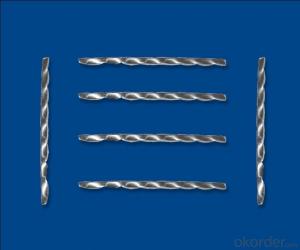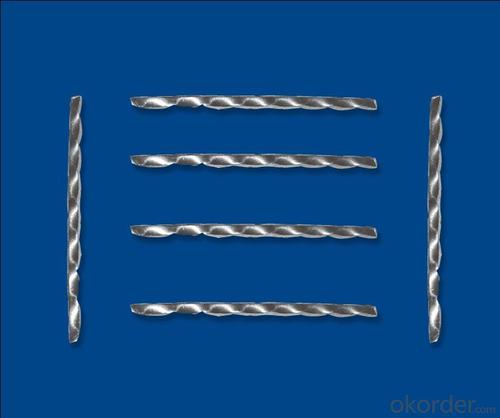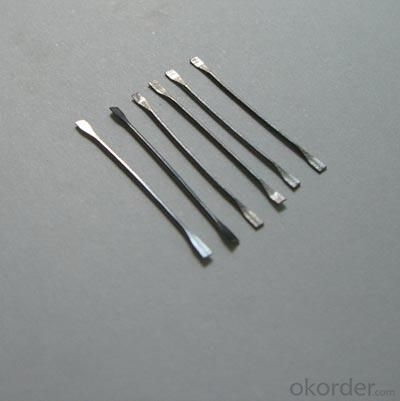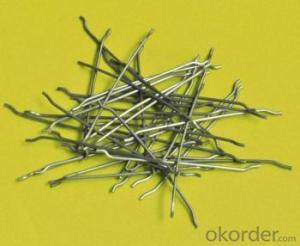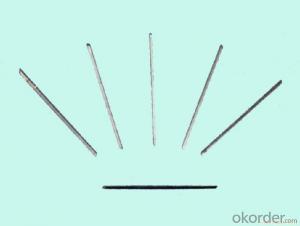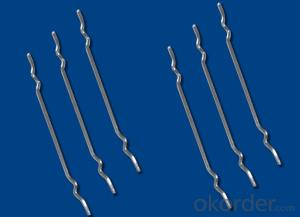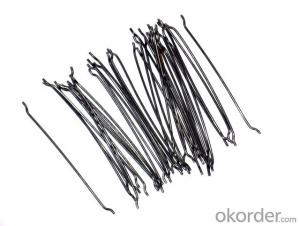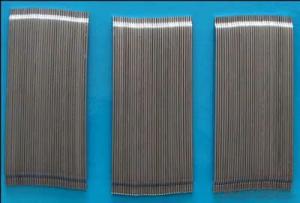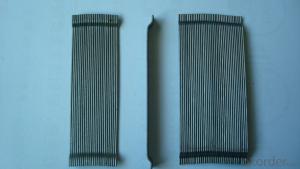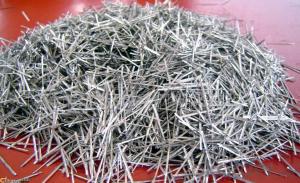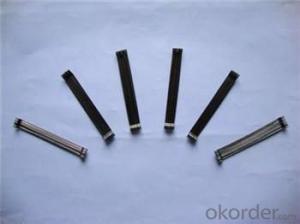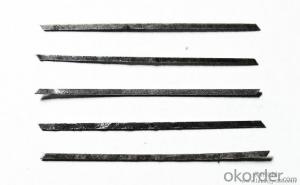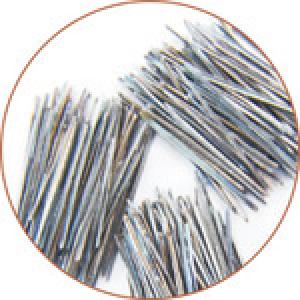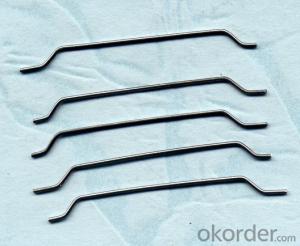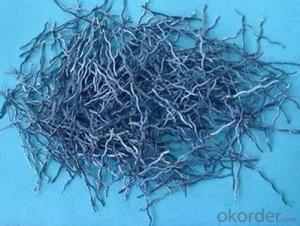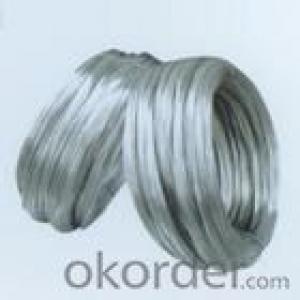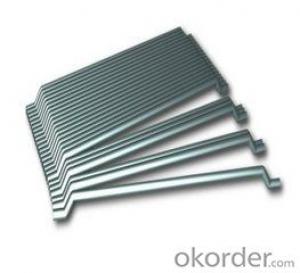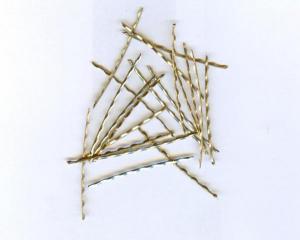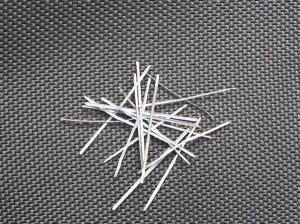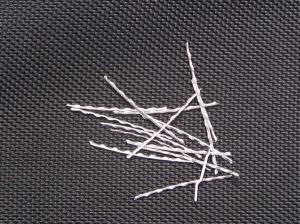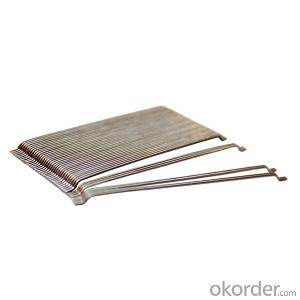Melt Extract Stainless Steel Fiber - Steel Fiber Popular Wholesale for Industrial Floor Minimum Tensile Strength
- Loading Port:
- Tianjin
- Payment Terms:
- TT OR LC
- Min Order Qty:
- 5 kg
- Supply Capability:
- 250000 kg/month
OKorder Service Pledge
OKorder Financial Service
You Might Also Like
Quick Details
Dimensions: steel wire
Grade: steel wire
Application: for concrete reinorcement
Shape: clear and bright
material: steel wire
type: wavy steel fiber
shape: corrugated flat fiber
usage: concrete reinforcement
appearance: clear and bright
Place of Origin: Shandong, China (Mainland)
Product features
steel fiber are for concrete construction, greatly improves concrete bonding and tensile strength .
Industrial floor
Precast elements
Tunnel bridge
Highway pavement
Airport pavement
The mining industry
Residential application
Concrete reinforcement
Corrosion protection
Military engine
Specifications
1: Goods: low carbon steel fiber
2: Brand: Jinzhuwang steel fiber
3:Process: Cold drawn
4:Certificate: CE, ISO9001
5:Specification is as follows
Item | Diameter (mm) | Length (mm) | Aspect Radio (L/D) | Tensile Strength (MPa) |
G50/ 25BN | 0.5 | 25 | 50 | ≥1100 |
G60/ 30BN | 0.5 | 30 | 60 | ≥1100 |
G70/ 35BN | 0.5 | 35 | 70 | ≥1100 |
G70/ 35BN | 0.6 | 25 | 42 | ≥1100 |
G50/ 30BN | 0.6 | 30 | 50 | ≥1100 |
G58/ 35BN | 0.6 | 35 | 58 | ≥1100 |
G40/ 30BN | 0.75 | 30 | 40 | ≥1100 |
G47/ 35BN | 0.75 | 35 | 47 | ≥1100 |
G80/ 60BN | 0.75 | 60 | 80 | ≥1100 |
G38/ 30BN | 0.8 | 30 | 38 | ≥1100 |
G44/ 35BN | 0.8 | 35 | 44 | ≥1100 |
G75/ 60BN | 0.8 | 60 | 75 | ≥1100 |
G56/ 50BN | 0.9 | 50 | 56 | ≥1100 |
G67/ 60BN | 0.9 | 60 | 67 | ≥1100 |
G50/ 50BN | 1.0 | 50 | 50 | ≥1100 |
G60/ 60BN | 1.0 | 60 | 60 | ≥1100 |
Picture

steel fiber concrete reinforced
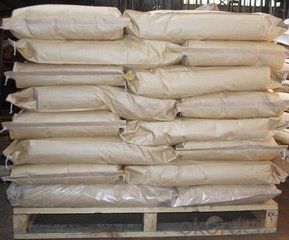

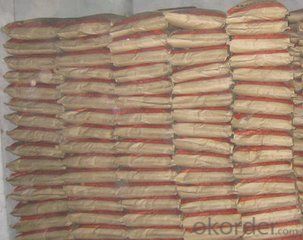
FAQ
we can produce any type steel fiber and of course we can make production according to your requirement
we have specilize in this field for almost 10 years ,with good quality and competitive price
a:Long durability
b:Once the project completed, the rate of crash will be declined a lot, a lot.
c:Economically effective
d:Steel fiber are proven the most effective and economical methods of building diverse concrete buidings
e:Extremely short project time
- Q: Are there any limitations or drawbacks of using melt extract stainless steel fiber?
- Using melt extract stainless steel fiber does have limitations and drawbacks. One limitation is the high cost associated with this type of fiber. Compared to other fibers, melt extract stainless steel fibers are expensive, making them less accessible for projects with budget constraints. Another drawback is the potential for corrosion. Although stainless steel fibers are generally resistant to corrosion, they are not completely immune. Depending on the environment and conditions they are exposed to, there is a possibility of corrosion occurring over time, compromising the fiber's durability and performance. Moreover, handling and installing melt extract stainless steel fibers can be challenging. They are typically stiff and difficult to bend, making it complex to incorporate them into certain applications or structures. This can lead to difficulties during installation and potentially impact the overall effectiveness of the fiber. Furthermore, the size and length of these fibers may also present limitations. They are usually available in shorter lengths compared to other fibers, restricting their use in applications that require longer fiber lengths. Lastly, the thermal conductivity of stainless steel fibers can be a drawback in certain situations. While their high thermal conductivity can be advantageous in some applications, it can also be a limitation. For projects where thermal insulation is a priority, the thermal conductivity of stainless steel fibers may not meet the desired requirements. In conclusion, while melt extract stainless steel fibers offer benefits such as high tensile strength and excellent resistance to high temperatures, it is important to consider their limitations and drawbacks before choosing them for a specific project or application.
- Q: How does melt extract stainless steel fiber affect the permeability of concrete to water?
- The use of melt extract stainless steel fiber in concrete can significantly affect its permeability to water. Stainless steel fibers are added to concrete mixtures to enhance its durability and improve the overall performance of the structure. When stainless steel fibers are incorporated into concrete, they create a three-dimensional network of reinforcement within the matrix. This network acts as a barrier that restricts the movement of water through the concrete. The fibers create a tortuous path for water molecules, reducing the permeability of the material. The presence of stainless steel fibers also helps to reduce the formation of microcracks in concrete. Microcracks can develop due to various factors such as shrinkage, temperature changes, and external forces. These cracks provide pathways for water to enter the concrete, increasing its permeability. However, the addition of stainless steel fibers helps to control and minimize the formation and propagation of these cracks, which in turn lowers the permeability of the concrete. Moreover, stainless steel fibers provide additional benefits to the concrete matrix by increasing its tensile strength and ductility. This enhanced strength helps the concrete to better withstand external loads and stresses, reducing the likelihood of crack formation and water penetration. In summary, the incorporation of melt extract stainless steel fiber in concrete positively affects its permeability to water. The fibers create a barrier that restricts the movement of water molecules and help to control the formation of microcracks, thereby reducing the permeability of the concrete.
- Q: What is the recommended fiber orientation for melt extract stainless steel fiber in concrete?
- Typically, the recommended fiber orientation for melt extract stainless steel fiber in concrete is a random or dispersed distribution. This means that the fibers should be evenly spread throughout the concrete matrix, without any specific alignment. This random distribution aids in improving the overall performance of the fiber-reinforced concrete by providing uniform reinforcement in all directions. It enhances the concrete's crack resistance, toughness, and durability, enabling it to withstand tensile and flexural stresses more effectively. Additionally, the random orientation helps to minimize the clumping or balling of fibers, ensuring a more efficient dispersion and integration of the stainless steel fibers within the concrete mixture.
- Q: Does melt extract stainless steel fiber increase the resistance to cracking in concrete?
- Yes, melt extract stainless steel fiber does increase the resistance to cracking in concrete. Stainless steel fibers are commonly added to concrete mixes as reinforcement to improve its tensile strength and prevent cracking. The addition of these fibers helps to distribute stress and reduce shrinkage, thus increasing the overall resistance to cracking in the concrete. Melt extract stainless steel fibers are particularly effective in enhancing the concrete's resistance to cracking due to their high tensile strength, durability, and superior bonding properties.
- Q: Can melt extract stainless steel fiber be used in thin concrete overlays?
- Thin concrete overlays can make use of melt extract stainless steel fiber. These fibers are commonly incorporated into concrete mixes to enhance their mechanical properties and bolster their durability. In the case of thin concrete overlays, where the concrete layer is less than 2 inches thick, the inclusion of stainless steel fibers can aid in reducing cracks and increasing resistance to shrinkage and impact. The fibers offer additional reinforcement and enhance the overall performance of the concrete overlay. However, it is imperative to ensure the correct dosage and even distribution of fibers throughout the mix for optimal outcomes. Furthermore, proper surface preparation and application techniques are vital for the successful utilization of melt extract stainless steel fiber in thin concrete overlays.
- Q: How does melt extract stainless steel fiber affect the rheology of self-compacting shotcrete?
- The rheology of self-compacting shotcrete can be significantly influenced by the inclusion of melt extract stainless steel fibers. To begin with, the incorporation of stainless steel fibers can enhance the viscosity and fluidity of the shotcrete mixture. These fibers act as reinforcements and aid in maintaining the stability and flow of the mixture, preventing segregation and settlement during application. This is especially crucial in self-compacting shotcrete, where achieving a high level of workability is necessary for proper consolidation and filling of desired areas. Furthermore, the stainless steel fibers also improve the cohesion and cohesiveness of the shotcrete mixture. Serving as bonding agents, these fibers enhance the interactions between particles, thereby increasing the strength and durability of the shotcrete. As a result, the material becomes more cohesive and stable, reducing the likelihood of cracking and shrinkage. Moreover, the presence of stainless steel fibers can also influence the setting time of the shotcrete. These fibers can expedite the hydration process and promote early strength development. This is advantageous in self-compacting shotcrete applications that require rapid setting and early strength to facilitate faster construction progress. In addition, the melt extract stainless steel fibers contribute to the overall ductility and toughness of the shotcrete. They offer additional resistance against crack propagation and enhance the structural integrity of the material. This is particularly important in self-compacting shotcrete as it improves performance under dynamic loading conditions and enhances the material's ability to withstand external forces. Overall, the inclusion of melt extract stainless steel fibers positively impacts the rheology of self-compacting shotcrete by enhancing viscosity, cohesion, setting time, and overall durability. Their addition improves the workability and performance of the shotcrete, making it highly suitable for various construction applications.
- Q: How does melt extract stainless steel fiber improve the durability of concrete?
- Melt extract stainless steel fiber improves the durability of concrete in several ways. Firstly, the addition of stainless steel fibers to concrete enhances its tensile strength and flexural properties. This means that the concrete becomes more resistant to cracking and can withstand higher levels of stress and load. The fibers act as reinforcement within the concrete matrix, effectively bridging any cracks that may occur and preventing them from propagating further. Moreover, stainless steel fibers also improve the impact resistance of concrete. The fibers absorb and distribute the impact energy, reducing the likelihood of surface spalling or fragmentation. This makes the concrete more durable and able to withstand heavy impacts or dynamic loading conditions. Additionally, stainless steel fibers enhance the resistance of concrete to corrosion. These fibers are made from stainless steel, which is highly resistant to rust and other forms of corrosion. By incorporating stainless steel fibers into the concrete mix, it creates a protective barrier against aggressive chemicals, moisture, and other environmental factors that can cause corrosion and deterioration. This significantly extends the lifespan of the concrete structure and reduces the need for costly repairs or replacements. In summary, melt extract stainless steel fiber improves the durability of concrete by enhancing its tensile strength, flexural properties, impact resistance, and corrosion resistance. This ultimately leads to a longer-lasting and more resilient concrete structure that can withstand harsh conditions and heavy use.
- Q: What is the effect of melt extract stainless steel fiber on the toughness of concrete?
- The addition of melt extract stainless steel fiber to concrete can have a positive effect on its toughness. Stainless steel fibers are typically used as reinforcement in concrete to enhance its mechanical properties, including toughness. When incorporated into concrete, these fibers act as tiny reinforcements, helping to distribute stress and prevent cracking. This reinforcement improves the overall toughness of the concrete, making it more resistant to impacts, vibrations, and other external forces. The melt extract stainless steel fibers are particularly effective in enhancing toughness due to their superior strength and durability. They are resistant to corrosion, which ensures their long-term effectiveness in concrete structures. Additionally, their small size and high aspect ratio allow for a better bond between the fibers and the surrounding matrix, further improving the overall toughness of the concrete. Overall, the addition of melt extract stainless steel fiber to concrete leads to an increase in its toughness, making it more resilient and durable. This can be particularly beneficial in applications where concrete is subjected to heavy loads, dynamic forces, or harsh environmental conditions.
- Q: Can melt extract stainless steel fiber be used in dam construction?
- Yes, melt extract stainless steel fiber can be used in dam construction. It is commonly used as a reinforcement material due to its high strength and resistance to corrosion. The fibers can enhance the durability and structural integrity of the concrete used in dam construction, making it a suitable choice for such projects.
- Q: Can melt extract stainless steel fiber be used in the construction of railway tracks?
- Yes, melt extract stainless steel fiber can be used in the construction of railway tracks. Stainless steel fiber is known for its high strength and durability, making it an ideal material for reinforcing concrete. In railway track construction, concrete is often used to create the foundation and support structures. By adding stainless steel fibers to the concrete mixture, the resulting material becomes stronger, more resistant to cracking, and able to withstand heavy loads and vibrations from passing trains. This can help increase the lifespan of the railway tracks and reduce maintenance and repair costs. Additionally, stainless steel fibers are corrosion-resistant, which is crucial in outdoor environments where the tracks are exposed to various weather conditions. Overall, the use of melt extract stainless steel fiber in railway track construction can enhance the structural integrity and longevity of the tracks.
Send your message to us
Melt Extract Stainless Steel Fiber - Steel Fiber Popular Wholesale for Industrial Floor Minimum Tensile Strength
- Loading Port:
- Tianjin
- Payment Terms:
- TT OR LC
- Min Order Qty:
- 5 kg
- Supply Capability:
- 250000 kg/month
OKorder Service Pledge
OKorder Financial Service
Similar products
Hot products
Hot Searches
Related keywords
